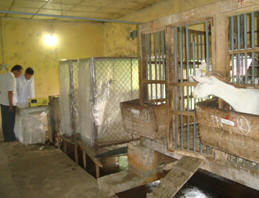 |
 |
|
Figure 1. Measuring methane in eructed gas from goats |
Figure 2. Adding nitrate salt to the diet lowers the ratio of methane to carbon dioxide in eructed gas froim goats |
|
Livestock-Based Farming Systems, Renewable Resources and the Environment |
Abstract
Sixteen Sannen dairy goats were used in randomized complete block design experiment to assess the effect of dietary addition of Nitrate (2% of DM) and Sulphate (2% of DM) and Molybdate (at 25ppm) on enteric methane production, blood nitrate and nitrite levels, milk yield and milk composition. Goats were gradually introduced to nitrate and sulfate and molybdate in a grass and concentrate basal diet over period of 4 weeks. The ratio of methane to carbon dioxide slightly decreased in goats fed nitrate and combined both molecules. DM intake of goats was not different among treatments. Milk yield were unaffected by addition, but lower protein of milk was observed in goats given nitrate treatments. The results indicated that supplement of a diet with nitrate and sulfate can be safely used to reduce enteric methane emission from dairy goats. The decreased energy loss did not improve milk yield and milk composition.
Keywords: dairy goat, methane, molybdate, nitrate, sulfate, ,
 |
 |
|
Figure 1. Measuring methane in eructed gas from goats |
Figure 2. Adding nitrate salt to the diet lowers the ratio of methane to carbon dioxide in eructed gas froim goats |